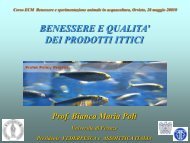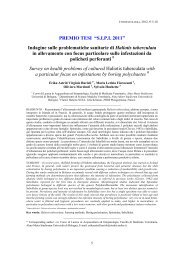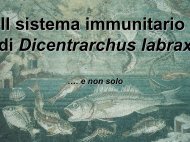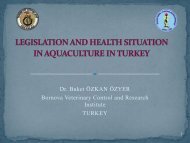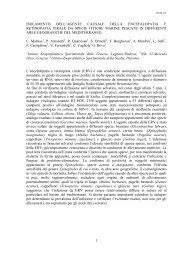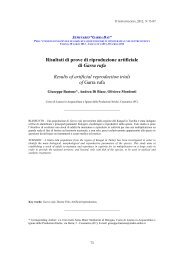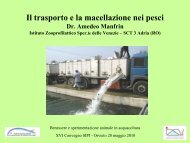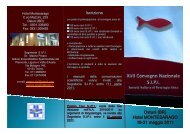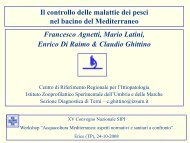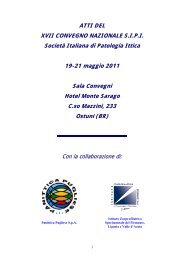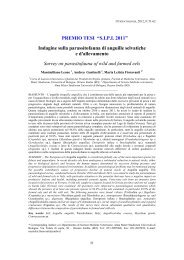ATTI DEL XV CONVEGNO NAZIONALE SIPI Società Italiana di ...
ATTI DEL XV CONVEGNO NAZIONALE SIPI Società Italiana di ...
ATTI DEL XV CONVEGNO NAZIONALE SIPI Società Italiana di ...
- No tags were found...
You also want an ePaper? Increase the reach of your titles
YUMPU automatically turns print PDFs into web optimized ePapers that Google loves.
Abstract Workshop<br />
LEGISLATION AND HEALTH SITUATION IN CROATIAN AQUACULTURE<br />
Snježana ZRNČIĆ, Dražen ORAIĆ<br />
Croatian Veterinary Institute, Dept. of Pathology, Laboratory for Fish Diseases, Savska<br />
143, 10000 Zagreb, Croatia<br />
Croatia is with its south part the Me<strong>di</strong>terranean country while with its northern part it<br />
belongs to the Central Europe. Aquaculture sector in Croatia is <strong>di</strong>verse and depends upon<br />
natural con<strong>di</strong>tions. Almost same quantities are produced in freshwater and marine<br />
aquaculture. Warm water freshwater aquaculture is situated in the continental (northern)<br />
part of the country and the major produced species are common carp (Cyprinus carpio),<br />
grass carp (Ctenopharyngodon idella), silver carp (Aristychthys nobilis), bighead<br />
(Hypophthaltmichthys molitrix), catfish (Silurus glanis), pike (Esox lucius) and pike perch<br />
(Zander lucioperca) while salmonids‟ farms are in the mountain region cultivating rainbow<br />
trout (Onchorhynchus mykiss) and brown trout (Salmo trutta m. fario). Along the Adriatic<br />
coastline long 5800 km there are several farms of sea bream (Sparus aurata), sea bass<br />
(Dicentrarchus labrax). Some quantities of fry for cultivation farmers are buying from 4<br />
Croatian hatcheries while the rest is imported from other Me<strong>di</strong>terranean countries. On the<br />
same farms small amounts of sharp snout sea bream (Diplodus puntazzo) and dentex<br />
(Dentex dentex) are produced. The farming of all mentioned species until market size is<br />
carrying out in cages of <strong>di</strong>fferent shape and size. In the recent decade some tuna (Thunnus<br />
thynnus) farms have been established. This type of aquaculture is based on the fattening<br />
captured fish of <strong>di</strong>fferent size, age and origin caught in Me<strong>di</strong>terranean Sea accor<strong>di</strong>ng to<br />
ICCAT. Cultivation of molluscs species; oysters (Ostrea edulis) and mussels (Mytilus<br />
galloprovincialis) has the longest tra<strong>di</strong>tion, from the Roman times. Overall annual<br />
production in fresh water and in the sea is about 16.000 tons and the consumption of fish is<br />
low, about 10 kg per capita. The major part of the production is being exported. Control of<br />
fish viral <strong>di</strong>seases listed by EC/OIE is performed accor<strong>di</strong>ng to the “Decree on the measures<br />
of animal health protection against infectious and parasite <strong>di</strong>seases” issued yearly by<br />
Ministry of Agriculture, Fisheries and Rural Development. During the present year an<br />
“Or<strong>di</strong>nance on animal health requirements for aquaculture animals and products thereof,<br />
and on the prevention and control of certain <strong>di</strong>seases in aquatic animals" based on Council<br />
Directive 2006/88/EC was been adopted. A field survey is carrying out to study the<br />
occurrence and <strong>di</strong>stribution of viruses causing <strong>di</strong>seases of major impact in salmonids,<br />
cyprinid or marine fish farming, namely viral haemorrhagic septicaemia (VHS), infectious<br />
haematopoietic necrosis (IHN) in salmonids, spring viraemia of carp (SVC) and koi herpes<br />
virosis (KHV) in cyprinds and viral encephalopathy and retinopathy (VER) in sea bass.<br />
The same regulation prescribes surveillance of molluscs <strong>di</strong>seases caused by Marteilia<br />
refringens and Bonamia ostreae. This report derives from systematic clinical,<br />
parasitological, pathoanatomical, histopathological, bacteriological and virological<br />
monitoring of cultivated fish and shellfish on larger part of production during last several<br />
years. Among pathological con<strong>di</strong>tions recognised on our farms, some specific viruses like<br />
infectious pancreatic necrocisis virus is present and there were an occurence of infecious<br />
haematopoetic necrosis virus in carantine. Bacterial <strong>di</strong>seases are very often the cause of<br />
mortalities in all kind of cultivated species. The most serious problems are caused by<br />
bacteria from the genus Aeromonas, Vibrio, Flavobacterium, Tenacibaculum and<br />
occasionally Photobacterium. Parasites represent frequently established causative<br />
nosologic agents but the most serious problems are caused by those caused my<br />
myxospori<strong>di</strong>ums. One of the very interesting problematic is pathology in tuna farming.<br />
Until now there were several outbreaks on the tuna farms along the coast, but until now<br />
there is no systematic approach to the study of the <strong>di</strong>seases and epizootiology of the some<br />
68



